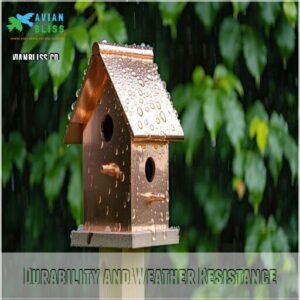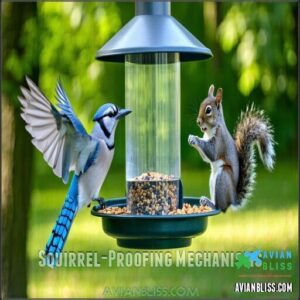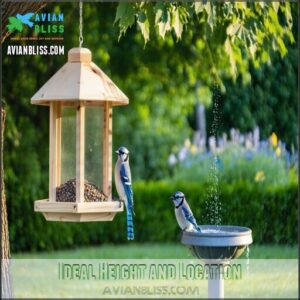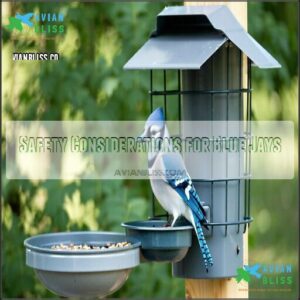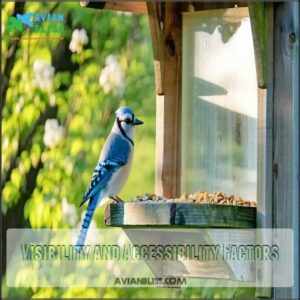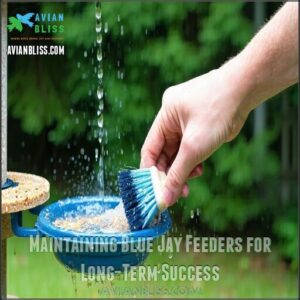This site is supported by our readers. We may earn a commission, at no cost to you, if you purchase through links.

Look for feeders made of durable materials like cedar or metal that can withstand both weather and the jays’ enthusiastic feeding habits.
Fill your feeder with peanuts, sunflower seeds, or corn – blue jays can’t resist these high-energy treats.
Position it near trees where these naturally cautious birds feel safe, and provide sturdy perches and wider openings to accommodate their size.
Many backyard enthusiasts discover that the right feeder turns occasional visitors into regular, colorful companions.
Table Of Contents
- Key Takeaways
- Blue Jay Feeding Habits and Preferences
- Key Features of Effective Blue Jay Feeders
- 7 Best Blue Jay Feeders for Backyard Birdwatching
- Optimal Placement of Blue Jay Feeders
- Maintaining Blue Jay Feeders for Long-Term Success
- Frequently Asked Questions (FAQs)
- What is the best bird feeder to attract blue jays?
- Why are blue jays not coming to my feeder?
- What food do blue jays like the most?
- What type of feeder is best for bluebirds?
- What is the 5 7 9 rule for bird feeders?
- What is a blue jays favorite food?
- How to befriend a blue jay?
- What is the best bird feeder to attract Blue Jays?
- What food do Blue Jays like the most?
- Where is the best place to put a blue jay feeder?
- Conclusion
Key Takeaways
- You’ll attract more blue jays with platform or tray-style feeders that provide ample space for these larger birds to land and feed comfortably, ideally placed 5-6 feet high near trees for quick escape routes.
- Fill your feeder with peanuts (both shelled and unshelled), black oil sunflower seeds, and corn – blue jays can’t resist these high-energy treats and will become regular visitors when these favorites are available.
- Choose feeders made from durable materials like cedar wood or powder-coated metal that can withstand both weather conditions and the jays’ enthusiastic feeding habits, with features like proper drainage to keep seeds dry.
- Clean your blue jay feeder weekly with mild soap solution to prevent disease transmission, and adjust your offerings seasonally – providing more protein-rich foods during breeding season and high-energy options in winter.
Blue Jay Feeding Habits and Preferences
Blue Jays are omnivores with a big appetite for peanuts, sunflower seeds, and berries, often grabbing food quickly before flying off.
Their size and bold behavior make sturdy, spacious feeders with wide perches the best choice to meet their needs.
Favorite Foods of Blue Jays
Blue Jays are backyard foodies with a knack for variety.
To attract them, serve these favorites:
- Peanuts – The ultimate Blue Jay feeder choice. Shelled or unshelled, peanuts are high-protein treats they keenly stash for later.
- Sunflower Seeds – Their go-to energy snack. Black oil sunflower seeds, rich in nutrients, keep Blue Jays coming back.
- Suet and Mealworms – Perfect protein boosts, especially for nesting season.
Seasonal fruits like berries or apples add flair to their diet, making your yard irresistible for these bold diners.
Feeding Behavior and Social Dynamics
Watching five Blue Jays interact at a feeder is like seeing a nature documentary right in your backyard.
These birds are smart, vocal, and socially complex.
Within their flocks, clear dominance hierarchies emerge, with the boldest birds often grabbing the first pick of food.
They’re experts in caching behavior, stashing seeds and nuts for later meals—an essential survival strategy.
You’ll notice younger Jays engaging in social learning, mimicking the feeding strategies of older, more experienced birds.
Their cooperative feeding style minimizes food competition when resources are plentiful.
Blue Jays prefer feeders with plenty of room, as their assertive nature and size can overwhelm smaller birds.
Opt for platforms or tray feeders to encourage peaceful interaction, letting you enjoy their spirited personalities without the drama.
Seasonal Variations in Blue Jay Diets
A blue jay’s eating habits shift with the seasons, reflecting their unique survival strategies.
In spring, they hunt protein-packed insects—just what they need for energy during migration. As summer rolls in, juicy berries and colorful fruits guarantee they’re getting the nutrients to thrive during breeding season.
Their diet’s variety makes them fascinating to watch.
By fall, blue jays turn industrious, gathering and stashing acorns and nuts like nature’s prepper pros. Winter, however, demands high-energy foods like peanuts and sunflower seeds to endure the cold.
Placing food in a sturdy blue jay feeder keeps them visiting all year.
- Spring: Protein-rich insects fuel migration.
- Summer: Berries and fruits dominate.
- Fall: Acorn and nut hoarding begins.
- Winter: High-energy foods are vital.
Natural Food Sources Vs. Feeder Options
It’s no surprise that blue jays balance their wild diet with a mix of foraging behavior and visits to backyard feeders, especially when seasonal availability is low.
In their natural habitat, they rely on acorns, berries, and insects for energy.
But feeders offer a welcome supplement—a buffet of sunflower seeds, peanuts, and corn that keeps them coming back.
You can easily attract blue jays by setting up a blue jay feeder with a sturdy, spacious design that matches their size.
These birds are quick to grab snacks and fly off, caching the food for later.
Blend natural options with feeder treats to give them a reliable source, rain or shine.
Key Features of Effective Blue Jay Feeders
When choosing a Blue Jay feeder, focus on sturdy designs that can handle their size and energetic feeding habits.
Look for features like wide perches, durable materials, and protections against squirrels to guarantee success.
Size and Capacity Requirements
If you’re picking a blue jay feeder, size really does matter. These striking birds, stretching 9–12 inches, need roomy feeders to settle in comfortably.
A well-thought-out large bird feeder guarantees they’ll stay longer to grab a bite. Check out a wide variety online for options.
Keep these dimensions in mind:
- Platform bird feeder depth: At least 12 inches for easy landing.
- Seed capacity: Choose 3–5 pounds to reduce refill runs.
- Tray depth: A 2–3 inch depth keeps seeds from spilling everywhere.
- Perch size: Go for 4-inch-wide perches to handle their weight.
- Food supply duration: Opt for designs holding 3–4 days’ worth of food.
A generously-sized feeder minimizes food waste and supports the needs of multiple jays. It’s a win-win for everyone!
Durability and Weather Resistance
When choosing a Blue Jay feeder, durability and weather protection are essential.
Jays are large, lively birds, and harsh weather can make things even tougher on your setup. A durable feeder saves you time, money, and frustration by standing up to both nature and the birds’ strong beaks.
To guarantee long-lasting performance, focus on these key features:
- Material Longevity – Cedar wood naturally resists rot, while powder-coated metals are excellent for rust resistance. Both are ideal for bird feeder durability.
- UV Stabilized Components – Plastic parts exposed to sunlight often crack, but UV protection prevents damage and extends feeder lifespan.
- Watershedding Design – Drainage holes and overhangs keep seeds dry and fresh, cutting down on waste and spoilage.
Investing in thoughtful designs like these guarantees your blue jay feeder can take on the elements and still shine for years. You can find a durable feeding option online.
Perch Design and Accessibility
When designing a blue jay feeder, it’s essential to prioritize accessibility and comfort for these larger birds.
Start with a wide perch—at least 4 inches long and sturdy enough to hold their weight. Use durable materials like metal or hardwood for long-lasting support.
For landing space, platform feeders work wonderfully, giving blue jays plenty of room to move while keeping seeds secure with raised edges.
Angle your perches slightly downward to mimic natural branches and add grip texture to prevent slipping. A platform feeder blue jays prefer often includes multiple entry points, encouraging peaceful feeding.
Place the feeder in an open, visible area so jays feel safe. With these thoughtful designs, your feathered visitors will thank you with their vibrant presence!
Squirrel-Proofing Mechanisms
Keeping squirrels out of your blue jay feeder can be a challenge, but smart tactics make it manageable.
Here’s how to keep the feast bird-friendly:
- Weight Activation: Squirrelproof feeders with weight-activated closures, like the Squirrel Buster, seal food ports when heavier animals land.
- Cage Barriers: Surround the feeder with cage designs that block squirrels but let birds in freely.
- Baffle Designs: Use pole guards or baffles, placed at least 8 feet from trees, fences, or other launch points.
- Feeder Materials: Invest in durable, chew-proof feeders made of steel or heavy-duty plastic.
- Placement Strategies: Hang feeders strategically, keeping them out of squirrels’ jumping range while ensuring visibility for Blue Jays.
One effective approach involves strategic bird feeder placement.
7 Best Blue Jay Feeders for Backyard Birdwatching
Finding the right feeder for Blue Jays means choosing one that suits their size, eating habits, and favorite snacks like peanuts and sunflower seeds.
Here are seven top feeders that combine durability, easy maintenance, and comfort for these lively backyard visitors.
1. Woodlink 3 in 1 Bird Feeder
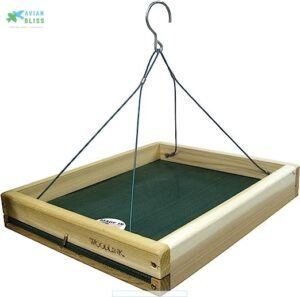
Looking for a feeder that’s versatile and built to last? The Woodlink 3 in 1 Bird Feeder is a perfect choice.
Made from reforested red cedar, it’s as sturdy as it’s eco-friendly. You’ll love its flexibility—it can hang, pole-mount, or rest on the ground.
With a 3-pound seed capacity, you won’t have to refill constantly, and the powder-coated metal screen bottom guarantees seeds stay dry with proper drainage.
Cleaning’s easy with the slide-out tray, saving time and effort. Though slightly pricey, its durability and functionality make it an excellent pick for making Blue Jays feel right at home.
Best For: Bird enthusiasts looking for a durable, versatile feeder that can attract both large and small birds in various settings.
- Higher price compared to similar feeders.
- Requires separate purchase of mounting hardware for pole installation.
- Limited seed capacity for users with high bird activity.
- Made from eco-friendly, reforested red cedar for durability.
- Versatile design allows hanging, pole-mounting, or ground placement.
- Easy to clean with a slide-out tray and removable screen.
2. Aspects Medium Seed Tube Feeder
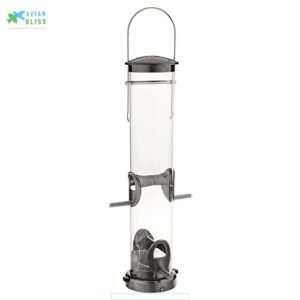
The Aspects Medium Seed Tube Feeder is a solid pick for attracting blue jays, combining durability and functionality.
With its 1.25-quart capacity and high-quality die-cast metal caps, it stands up to tough weather. The four feeding ports mean you can watch multiple birds enjoy their meal at once—a treat for any birdwatcher!
Its built-in seed deflector guarantees no seed goes to waste, while the quick-clean removable base makes maintenance simple. The UV-stabilized polycarbonate tube resists wear and allows you to monitor seed levels effortlessly.
Plus, responsive customer support has you covered for any part replacements. It’s reliable, easy to use, and bird-friendly!
Best For: Birdwatchers looking for a durable, easy-to-clean feeder that attracts a variety of bird species.
- Durable die-cast metal caps and UV-stabilized polycarbonate tube for longevity.
- Built-in seed deflector ensures no wasted seeds.
- Quick-clean removable base simplifies maintenance.
- Limited to 1.25-quart capacity, requiring frequent refills for heavy bird activity.
- Higher price range compared to some similar feeders.
- Some finishes or models may occasionally be backordered.
3. Whole Peanut Black Wreath Feeder for Squirrels and Blue Jays
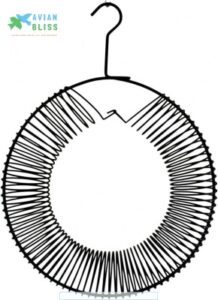
The Whole Peanut Black Wreath Feeder is a fantastic choice for blue jay enthusiasts.
Its spiral wire design isn’t just eye-catching—it’s functional, too. Birds and squirrels have to work a little to grab their treats, making it as much a puzzle as a feeder.
Blue jays, known for their cleverness, will love the challenge, while squirrels stay entertained and away from other feeders.
Built with durable, powder-coated steel, this feeder is tough enough to handle weather and frequent visits from wildlife. Blue jays especially appreciate the unsalted, in-shell peanuts it holds, an ideal snack filled with energy.
You can easily hang this compact feeder on trees or poles, fitting seamlessly into your backyard setup. As well as keeping your feathered (and furry) friends happy, it also provides hours of entertainment.
Watching jays and squirrels problem-solve is a joy you won’t want to miss!
Best For: Wildlife lovers who enjoy feeding and observing blue jays, woodpeckers, and squirrels in their backyard.
- Durable steel construction withstands weather and heavy use.
- Attracts a variety of birds like blue jays, woodpeckers, and nuthatches.
- Keeps squirrels entertained and away from other feeders.
- Smaller birds may have difficulty accessing peanuts.
- Frequent refilling needed due to high consumption.
- Peanut shells can cause mess, requiring regular cleanup.
4. Kingsyard Large Capacity Bird Feeder
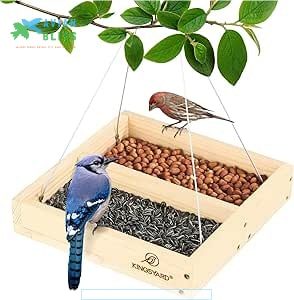
The Kingsyard Large Capacity Bird Feeder is a sturdy, no-nonsense option that combines durability with functionality.
Built from weatherproof New Zealand pine and rustproof steel, it easily withstands rain and sun, making it ideal for year-round birdwatching.
The feeder features dual compartments, allowing you to offer Blue Jays their favorite snacks, like peanuts and sunflower seeds, simultaneously.
Its 11×11-inch spacious platform and mesh bottom guarantee comfort for larger birds while keeping seeds fresh with proper drainage.
Blue jays also enjoy having fresh water available for drinking and bathing.
With a 2-pound seed capacity, you won’t be refilling it constantly, which is a significant convenience, although cleaning can be a bit tricky, it’s a small trade-off for the convenience and bird appeal this feeder brings to your yard.
Best For: Homeowners who want a durable, spacious bird feeder that attracts a variety of bird species including larger birds like blue jays and cardinals.
- Cleaning is challenging due to the non-removable mesh bottom.
- Paint may peel after rain exposure, affecting aesthetic and safety.
- Seeds can get stuck in the mesh, limiting bird access.
- Durable, weatherproof materials that withstand year-round use.
- Spacious platform accommodates multiple large birds at once.
- Dual compartments allow for offering different seed types.
5. Cedar Tail Prop Suet Bird Feeder
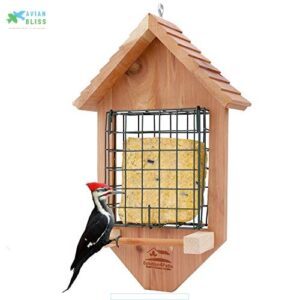
The Cedar Tail Prop Suet Bird Feeder is a solid pick for blue jay fans.
Its tail prop landing guarantees bigger birds, like blue jays, can feed comfortably. Crafted from USA cedar, it’s weather-resistant and naturally attractive to birds.
The sturdy roof protects suet cakes from rain, while a squirrel-proof clasp helps keep pests out. It holds one standard suet cake and refilling is a breeze.
For longevity, apply bird-safe oil periodically to maintain the cedar. Some users note minor durability concerns, but overall, this feeder offers a reliable, bird-friendly design for your backyard haven.
Best For: Backyard bird watchers looking to attract larger birds like blue jays and woodpeckers with a simple, natural design.
- Made from durable, weather-resistant USA cedar.
- Includes tail prop landing for comfortable feeding by larger birds.
- Squirrel-proof clasp protects suet cakes.
- Requires periodic maintenance for weather protection.
- Durability concerns like wood rot and loose screws reported by some.
- Suet cage might feel flimsy and require reinforcement.
6. Large Panorama Wild Bird Feeder

In the case of feeding Blue Jays, the Large Panorama Wild Bird Feeder is a game-changer.
Its two-tiered seed trays and circular perches create the perfect space for these social birds to dine comfortably.
With a generous 4.5-pound seed capacity, you’ll refill less often and enjoy more birdwatching.
The Sure-Lock cap helps keep squirrels out, making sure your feathered guests get the feast to themselves.
Made with a weather-resistant bronze, this feeder is as durable as it’s attractive.
Easy to install using its 12-inch hanging hook, it’s a reliable choice for turning your backyard into a bird-lover’s haven.
Best For: Bird enthusiasts looking to attract a variety of wild birds while minimizing frequent refills and maintaining durability.
- Attracts a wide range of bird species, including Blue Jays and Cardinals.
- Large 4.5 lb seed capacity reduces refilling frequency.
- Durable and weather-resistant bronze finish ensures long-lasting use.
- Not completely squirrel-proof despite the Sure-Lock cap.
- Seed spillage can create a mess in confined areas.
- Bottom chamber is difficult to clean thoroughly.
7. High Energy Wild Bird Suet
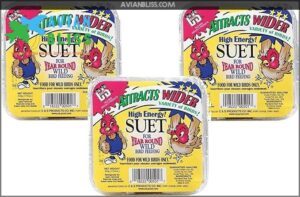
Looking for an easy way to draw blue jays to your yard? High Energy Wild Bird Suet might be your best bet! Packed with beef suet, black oil sunflower seeds, and nuts, it’s a high-energy snack that blue jays, woodpeckers, and nuthatches can’t resist.
Think of it as a power bar for birds! Pop a suet cake into a small basket or wire feeder and hang it where birds can perch comfortably.
To keep pesky starlings at bay, try using an upside-down suet feeder. The melt-resistant formula guarantees it stays fresh, even in summer heat. With minimal maintenance—just check weekly—it’s a perfect low-effort choice for birdwatchers.
Best For: Bird enthusiasts looking to attract larger, energetic birds like blue jays, woodpeckers, and nuthatches to their feeders.
- High-energy formula attracts a variety of bird species.
- Melt-resistant, suitable for year-round use.
- Simple to use with small wire or basket feeders.
- Squirrels often compete for access.
- May not cater to smaller birds due to larger bird dominance.
- Occasional packaging issues with messiness or sticking.
Optimal Placement of Blue Jay Feeders
Placing your Blue Jay feeder in the right spot can make all the difference in attracting these vibrant birds.
Keep it high enough to avoid predators but visible, so they feel safe while stopping by for a meal.
Ideal Height and Location
Getting the height of your blue jay feeder just right helps with both safety and comfort. Aim for 5-10 feet off the ground to deter predators and allow easy access for jays.
Choose spots wisely for your bird feeder placement.
- Predator Avoidance: Keep feeders away from areas where cats might pounce.
- Weather Exposure: Avoid overhangs that could cause seeds to get soggy during rain.
- Territorial Considerations: Maintain some distance from other feeders to reduce competition.
- Sun/Shade Balance: Place feeders in partially shaded spots to attract blue jays while protecting food.
Safety Considerations for Blue Jays
Creating a safe bird feeder setup for Blue Jays means thinking a step ahead of threats. Position your feeder carefully—open spaces work best but avoid dense shrubs that might hide prowling cats. It’s like designing a protective café for birds: inviting yet secure.
- Add squirrel-proof feeders to keep squirrels and raccoons from stealing food.
Prevent window collisions with UV decals or external screens. Practice good hygiene by cleaning feeders often and avoiding moldy food. Mold from wet peanuts or seeds can harm Blue Jays.
Predator avoidance matters, so choose spots where birds can spot danger but still retreat safely. Thoughtful bird feeder placement makes all the difference for these colorful visitors.
Visibility and Accessibility Factors
To attract Blue Jays, place your feeder about 5-6 feet high for ideal feeder height.
Opt for open spaces with clear flightpaths to reduce stress and improve visibility.
Tray or platform bird feeders offer easy access and comfortable feeding.
To prevent window collisions, maintain a safe distance from windows.
Add nearby branches for resting, and consider a weather shielding option to keep food fresh.
Make certain the feeder is stable and easy to clean, preventing accidents and guaranteeing lasting enjoyment for your feathered visitors.
Multiple Feeder Arrangements
While visibility helps blue jays spot food, multiple feeding stations create a balanced ecosystem in your yard.
Strategic feeder arrangements benefit both birds and your viewing experience:
- Place a tray feeder with sunflower seeds near protective tree cover
- Position a peanut wreath feeder at eye level for easy viewing
- Add a platform feeder in an open area with complementary foods
- Install suet feeders on opposite sides to minimize competition
- Create a "feeder trail" that encourages natural foraging behaviors
This spatial distribution attracts more blue jays and also reduces crowding at any single feeding station.
Maintaining Blue Jay Feeders for Long-Term Success
You’ll need to clean your blue jay feeder weekly with a mild soap solution to prevent seed mold and disease transmission between birds.
Regular maintenance guarantees your feathered visitors return consistently, as blue jays quickly abandon dirty or unreliable food sources in favor of healthier options, and this is crucial for their well-being and the success of your feeder, making regular maintenance a must.
Cleaning and Sanitization Techniques
Regular cleaning of your blue jay feeder prevents disease outbreaks among your feathered visitors.
Bird droppings can harbor harmful bacteria that spread quickly at busy feeding stations.
- Scrub thoroughly with hot water and safe detergents designed for bird equipment
- Rinse feeders completely after washing to remove all soap residue
- Disinfect monthly with a 9:1 water-to-bleach solution for 10 minutes
- Air-dry feeders completely before refilling to prevent mold growth
- Prioritize easy-to-clean designs with removable parts for thorough sanitation
A clean feeder isn’t just about appearances—it’s about keeping your backyard blue jays healthy and returning for years to come. To maintain hygiene, you may want to purchase a specialized feeder cleaner to ensure your feeder remains clean and safe for the birds, promoting a healthy environment.
Refilling Schedules and Food Freshness
Blue jays turn their beaks up at stale offerings, making proper refill schedules essential for backyard success.
- Refill Frequency: Check feeders every 2-3 days, more often during rainy periods to prevent seed spoilage and birdseed mold.
- Moisture Control: Empty and dry feeders after rain to minimize bacteria growth that could harm your jays.
- Optimal Storage: Keep birdseed in airtight containers in cool, dry places to maintain freshness.
- Cleaning Impact: Thoroughly clean feeders before each refill to prevent harmful birdseed bacteria from developing.
Fresh food equals frequent visitors—it’s that simple.
Seasonal Maintenance and Weather Protection
How well are you protecting your blue jay feeders from seasonal challenges? Proper weather protection extends feeder life and keeps visiting birds healthy.
Winterizing feeders means adding wind shields and ensuring drainage solutions prevent frozen food. When summer heat arrives, position feeders in partial shade to prevent seed spoilage.
Spring and fall demand regular bird feeder maintenance to prevent mold formation. * A rain guard acts like an umbrella, keeping seeds dry during unexpected showers
- Weather proofing with rust-resistant hardware prevents material degradation
- Proper drainage solutions create escape routes for moisture that would otherwise cause mold
Seasonal feeder cleaning prevents diseases that can spread among your blue jay visitors.
Monitoring and Adjusting Feeder Performance
Think of your blue jay feeder as a living system that needs regular check-ups and fine-tuning.
By monitoring bird activity daily, you’ll quickly notice changes in seed consumption rate or feeding patterns. If you see less traffic, try adjusting the feeder’s height or moving it away from busy areas.
Keep track of feeder material degradation, especially after storms. Weather impact adjustments might include adding a baffle or dome during rainy seasons.
When squirrels become persistent, implement squirrel interference solutions like greasing poles or installing baffles. Bird feeding strategies should evolve with the seasons – offer more protein-rich options in breeding seasons.
Consider the importance of feeder location to maximize bird attraction and safety. Pay attention to which foods disappear fastest and adjust your offerings accordingly. Sometimes simply changing the type of sunflower seeds or adding peanuts can dramatically increase visits to your feeder.
Frequently Asked Questions (FAQs)
What is the best bird feeder to attract blue jays?
Platform or tray feeders work best for attracting blue jays, as they’ll need space for their larger size.
Fill it with peanuts (shelled or unshelled) and sunflower seeds – they can’t resist these treats!
Why are blue jays not coming to my feeder?
Your feeder might be too small or unstable for these larger birds.
They’re picky eaters too!
Try offering peanuts, sunflower seeds, or suet in a platform feeder with plenty of space.
What food do blue jays like the most?
Blue jays absolutely love peanuts – both shelled and unshelled varieties.
They’re also fans of black oil sunflower seeds, acorns, suet, and corn.
You’ll see them quickly grab these treats and fly off to cache them.
What type of feeder is best for bluebirds?
Did you know bluebirds can spot insects from 50 yards away?
You’ll want specialized mealworm feeders with 1½" entrance holes to keep out larger birds.
A hanging feeder with a dome top protects their food while they dine.
What is the 5 7 9 rule for bird feeders?
To outsmart hungry squirrels, you’ll need to position your feeder 5 feet above ground, 7 feet away from jumping points like fences or trees.
This positioning limits their impressive jumping abilities, as it also requires the feeder to be 9 feet below any overhanging branches.
What is a blue jays favorite food?
While many think it’s just seeds, blue jays actually prefer peanuts above all else.
You’ll find they love unsalted peanuts (both shelled and unshelled), sunflower seeds, suet, and seasonal berries too.
How to befriend a blue jay?
Begin by offering peanuts consistently at the same times each day.
Sit quietly nearby while they feed, gradually decreasing your distance.
Don’t make sudden movements. Patience will earn their trust over weeks.
What is the best bird feeder to attract Blue Jays?
You’d think blue jays would be picky customers, but they’re not. Platform feeders or peanut wreaths work best for them. Fill with peanuts, sunflower seeds, or corn for guaranteed visits.
What food do Blue Jays like the most?
Blue jays absolutely love peanuts, especially whole, unsalted ones in the shell.
They’ll also happily devour black oil sunflower seeds, suet, corn, and acorns, often grabbing these treats to cache for later.
Where is the best place to put a blue jay feeder?
Place your feeder near trees but with open space around it, about 10-15 feet from cover.
You’ll want it mounted 5-6 feet high where you can easily refill it and jays can quickly retreat to safety.
Conclusion
Ultimately, your best blue jay feeder investment pays dividends in vibrant wildlife visits throughout the year.
With the right platform design, sturdy materials, and favorite treats like peanuts and sunflower seeds, you’ll transform your backyard into a blue jay haven.
Remember to place your feeder near protective trees, clean it regularly, and keep it stocked with fresh offerings.
You’re not just feeding birds—you’re creating a colorful relationship with these intelligent, charismatic backyard companions.
- https://www.thespruce.com/how-to-attract-jays-386261
- https://www.farmandfleet.com/blog/tips-for-attracting-blue-jays/
- https://www.nationalgeographic.com/animals/birds/b/blue-jay/
- https://www.perkypet.com/perky-pet-copper-panorama-312c?srsltid=AfmBOooumZ5LdT-_H2Hjw2LSj0cH7H6gc64sG8QHsOlFav4bVmiasDNC
- https://www.walmart.com/ip/Perky-Pet-Copper-Panorama-Bird-Feeder/21296080



